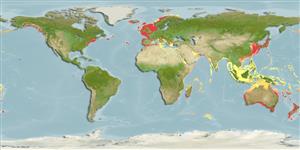Common names from other countries
Classification / Names / Names
Namen | Synonyme | Catalog of Fishes (gen., sp.) | ITIS | CoL | WoRMS
Environment: milieu / climate zone / depth range / distribution range
Ökologie
Pelagisch; tiefenbereich 0 - 250 m (Ref. 1134). Subtropical; 7°C - 30°C (Ref. 1134)
Atlantic, the Mediterranean and Indo-Pacific. Tropical to temperate.
Length at first maturity / Size / Gewicht / Alter
Maturity: Lm ? range ? - ? cm Max length : 60.0 cm COLD Männchen/unbestimmt; (Ref. 1610)
Minimum depth from Ref. 116065.
Life cycle and mating behavior
Geschlechtsreife | Fortpflanzung | Ablaichen | Eier | Fecundity | Larven
Members of the order Pyrosomatida includes clonal and sexual phases in its life cycle. Life cycle: Eggs develop into lecithotrophic oozooid (cyathozooid) which undergo budding to form four blastozooids. The oozoid degenerates and the colony is formed from the blastozooids.
Kott, P. 2005. (Ref. 1134)
IUCN Rote Liste Status (Ref. 130435: Version 2024-1)
CITES Status (Ref. 108899)
Not Evaluated
Not Evaluated
Nutzung durch Menschen
| FishSource |
Tools
Mehr Information
Alter/Größe
Wachstum
Länge-Gewicht
Länge-Länge
Morphologie
Larven
Dichte
Internet Quellen
Estimates based on models
Verwundbarkeit
Moderate vulnerability (44 of 100).
Preiskategorie
Unknown.
